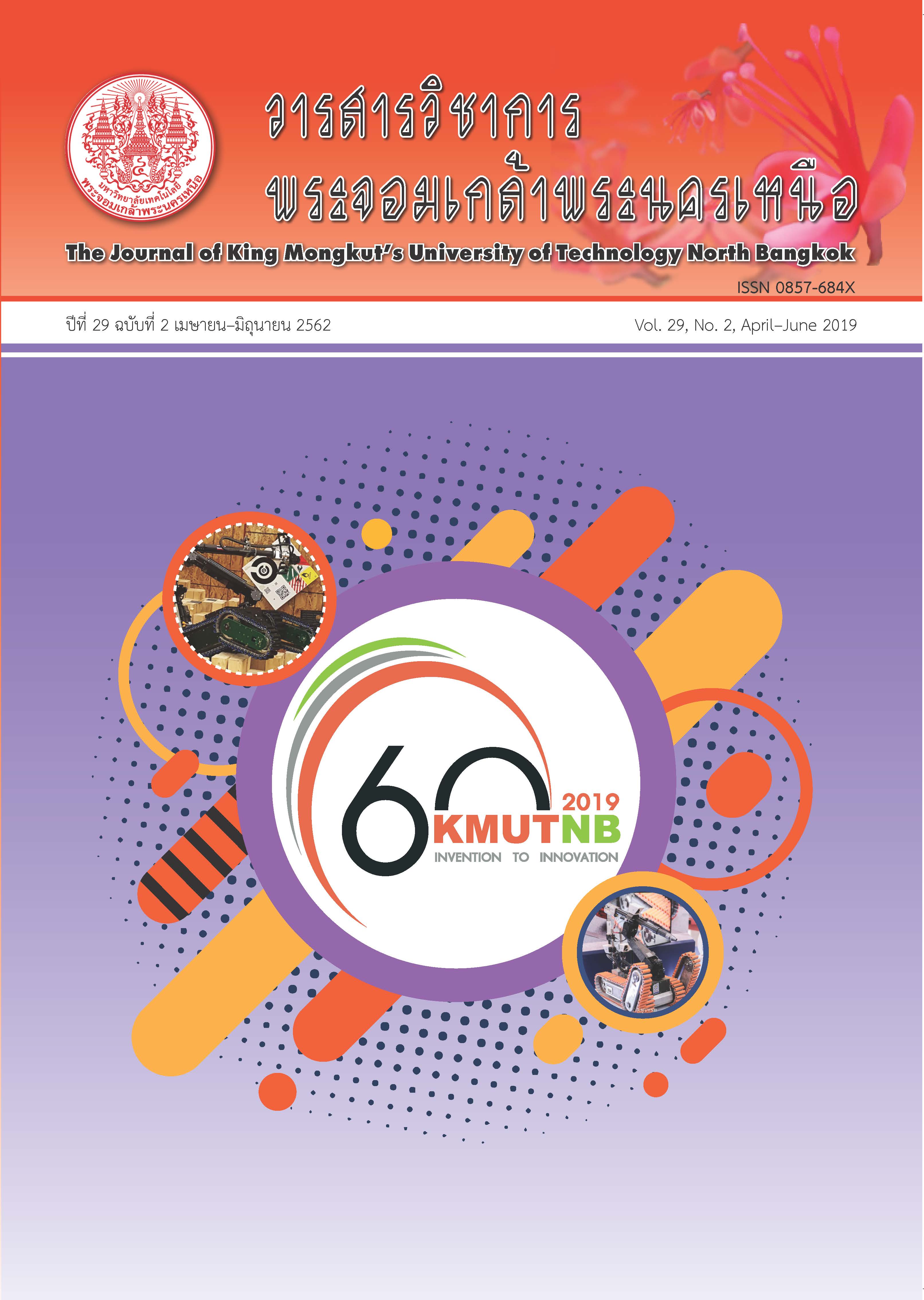Utilization of Rice Husk Ash-based Geopolymer in Hollow Load-bearing Concrete Masonry Block
Main Article Content
Abstract
This research aims to study the effects of aggregate content, Sodium Hydroxide (NaOH) concentration and curing temperature on compressive strength and water absorption of load-bearing geopolymer concrete blocks. Original coarse rice husk ash blended with fly ash at the percentage by weight of 50 : 50 was used as a binder. Sodium Silicate (Na2SiO3) and Sodium Hydroxide (NaOH) solutions were also mixed with the binder to produce geopolymer concrete blocks. NaOH solution concentrations were varied at 12, 14, 16, and 18 molars. Dust limestone was also used as an aggregate in the mixture at various weight ratios between the binder (rice husk ash blended with fly ash) and aggregate, ranging from 1 : 4, 1 : 6 and 1 : 8. The geopolymer concrete blocks were produced by the Cinva-Ram machine. The specimens were then arranged into two groups at the temperatures of 25°C (room temperature) and 65°C for the first 24-hour curing; then all the specimens were cured in room temperature until the testing ages. The geopolymer concrete block specimens were tested for compressive strength at 7, 14, and 28 days and its water absorption was tested at 28 days. The results showed that higher NaOH solution concentration led to higher compressive strength and lower water absorption of geopolymer concrete blocks. These effects were evidently found in geopolymer concrete blocks with low aggregate content than in those with high aggregate content. An Increase of aggregate content in the mixture also decreases compressive strength of geopolymer concrete blocks. In addition, geopolymer concrete blocks, which were cured at 65°C for 24 hours apparently yielded higher compressive strength than those cured at 25°C (room temperature). Besides, high curing temperature has a greater effect to increase compressive strength of geopolymer concrete blocks with lower NaOH concentration than their counterparts with higher NaOH concentration.
Article Details
The articles published are the opinion of the author only. The author is responsible for any legal consequences. That may arise from that article.
References
[2] U. Rattanasak and P. Chindaprasirt, Rice Husk Ash in Concrete, 1th ed. Bangkok: Thailand Concrete Association, 2010 (in Thai).
[3] U. Chatveera and P. Srinourn, “A study of properties of mortar portland cement type V mixed with ground rice husk ash and limestone powder,” KMUTT Research and Development Journal, vol. 35, no. 2, pp. 201–218, 2012 (in Thai).
[4] R. Soeurt and W. Chalee, “Compressive strength improvement of concrete containing rice husk ash using an alkaline activator,” Journal of King Mongkut’s University of Technology North Bangkok, vol. 26, no. 3, pp. 347–357, 2016 (in Thai).
[5] Q. Feng, H. Yamamichi, M. Shoya, and S. Sugita, “Study on the pozzolanic properties of rice husk ash by hydrochloric acid pretreatment,” Cement and Concrete Research, vol. 34, no. 3, 2004, pp. 521–526, 2004.
[6] K. Kuennokkhum, W. Koraviyothin, and W. Chalee, “Effect of Na(OH) concentration on water flow rate and compressive strengths of fly ash-based geopolymer porous concrete,” Journal of King Mongkut’s University of Technology North Bangkok, vol. 24, no. 1, 2014, pp. 56–65 (in Thai).
[7] P. Chindaprasirt, C. Jaturapitakkul, W. Chalee, and U. Rattanasak, “Comparative study on the characteristics of fly ash and bottom ash geopolymers,” Waste Manage, vol. 29, no. 2, pp. 539–543, 2009.
[8] U. Rattanasak and P. Chindaprasirt, “Influence of Na(OH) solution on the synthesis of fly ash geopolymer,” Minerals Engineering, vol. 22, no. 12, pp. 1073–1078, 2009.
[9] Hollow load-bearing masonry units, Thai Industrial Standard TIS 57-2533, 1990 (in Thai).
[10] Standard Specification for Coal Fly Ash and Raw or Calcined Natural Pozzolan for Use in Concrete, Annual Book of ASTM Standards 04. 02, C618, 2003.
[11] Standard Test Method for Specific Gravity and Absorption of Coarse Aggregate, Annual Book of ASTM Standards 04. 02, C127, 2001.
[12] P. Huy, S. Mov, and W. Chalee, “Production of hollow load-bearing concrete masonry blocks from fly ash-based geopolymer,” Burapha Science Journal, vol. 12, no. 2, pp. 31–46, 2016 (in Thai).
[13] Standard Test Method for Density, Absorption, and Voids in Hardened Concrete, Annual Book of ASTM Standards 04. 01, C642-97, 2001.
[14] N. Phatitriwatt and W. Chalee, “Effect of temperature curing on compressive strength of fly ash-based geopolymer mortar,” KMUTT Research and Development Journal, vol. 40, no. 3, pp. 355–364, 2017 (in Thai).
[15] P. Chindaprasirt, U. Rattanasak, and S. Taebuanhuad, “Resistance to acid and sulfate solutions of microwave-assisted high calcium fly ash geopolymer,” Materials and Structures, vol. 46, no. 3, pp. 375–381, 2013.
[16] P. Chindaprasirt and W. Chalee, “Effect of sodium hydroxide concentration on chloride penetration and steel corrosion of fly ash-based geopolymer concrete under marine site,” Construction and Building Materials, vol. 63, pp. 303–310, 2014.
[17] S. Hanjitsuwan, S. Hunpratub, P. Thongbai, S. Maensiri, V. Sata, and P. Chindaprasirt, “Effects of NaOH concentrations on physical and electrical properties of high calcium fly ash geopolymer paste,” Cement and Concrete Composites, vol. 45, pp. 9–14, 2014.
[18] C. Sanawong, S. Somna, and W. Chalee, “Compressive and bond strengths of fly ashbased geopolymer concrete,” Burapha Science Journal, vol. 15, no. 1, pp. 13–22, 2010 (in Thai).
[19] U. Rattanasak and W. Chalee, “Study of leaching of lignite fly ash and strength of fly ash based-geopolymer,” KMUTT Research and Development Journal, vol. 29, no. 4, pp. 437–446, 2006 (in Thai).
[20] W. Chalee, P. Ausapanit, and C. Jaturapitakkul, “Utilization of fly ash concrete in marine environment for long term design life analysis,” Materials and Design, vol. 31, no. 3, pp. 1242–1249, 2010.
[21] K. Charoenprom and W. Chalee, “Relation between water permeability and chloride diffusion coefficient of concrete under 10-year exposure in marine environment,” Journal of King Mongkut’s University of Technology North Bangkok, vol. 23, no. 1, pp. 29–41, 2013 (in Thai).

